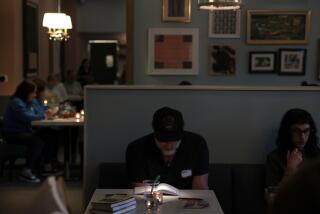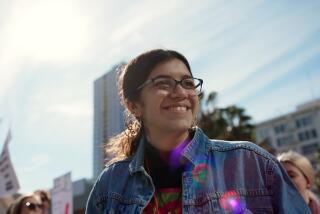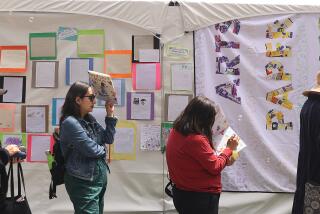Poets Say Their Pieces in Long Beach--and People Listen
- Share via
LONG BEACH — The room was long and narrow, with glistening glass table-tops and metallic gray walls.
One by one, the poets rose to share their visions.
Victor Charles III, a 25-year-old free-lance psychic and acknowledged homosexual, read a poem called “Michael’s Face Makes Me Feel Beautiful.”
Kate McClatchy, 26, an unemployed teacher and political activist, read a series of angry pieces railing at the oppression of peasants in Central America and of women at home. “I’ve got patriarchy in my bed,” she read. “ I am buried alive.”
And Heidi Ziolkowski, 29, looking smart in a tailored red suit with matching shoes and sleek black hose, read sweet poems of motherly love and graphic, erotic descriptions of sex with foreign men.
“I like the energy from the crowd,” she said afterward. “Before I read poetry, I used to read the lesson at church services.”
Just another Wednesday evening at System M, the city’s newest and, by most accounts, hippest hangout. But wait, something deeper is happening. While the poets are reading, others seem to be listening.
Poetry readings, in fact, are abounding. Some call it the beginning of a local renaissance of interest in the spoken word.
“It’s very exciting,” said Dixie Swift, cultural programs supervisor for the city’s Department of Parks and Recreation. “It hasn’t been like this since the 1960s.”
In fact, Long Beach has had an active poetry scene for at least 20 years. Attracted by California State University, Long Beach, where such poetic luminaries as Gerald Locklin and Charles Stetler have instructed generations of students in the skills of their art, would-be poets in the city have long gathered to share their works among themselves. In 1975, a local bookstore--Chelsea Books--began holding a series of regularly scheduled readings that lasted 10 years and made the place something of a headquarters to the city’s burgeoning poetic community.
In 1985, those readings ceased after the store moved to a new location lacking the required space. But in the two years since, an interesting phenomenon has occurred: poetry readings, some open to anyone who wants to take the stage and others featuring well-known artists, have begun cropping up throughout the city.
Today as many as 150 poetry aficionados show up for monthly readings at The Works Gallery, a 2,400-square-foot art showcase on Broadway. Another monthly series takes place aboard the Queen Mary, sponsored by Long Beach poet Bernard Sango.
And the Long Beach Museum of Art recently joined the field by attracting 250 lovers-of-the-word to a weeknight compilation of poetry and music.
In addition, Interchange Magazine--a local arts publication--has held occasional readings, as has the Uprising Theater, a small experimental company devoted to new works. This week, in fact, the theater--on 7th Street--is premiering a program featuring an actor who will perform Shakespearean sonnets teamed with a balladeer who will sing folk songs of the English-speaking world.
Readings With Music
And since opening 10 months ago, System M--the sleek European-style coffee house/restaurant/art gallery downtown--has held numerous poetry readings, many backed by music. The readings have attracted anywhere from a handful to more than 100 people. Wednesday night’s performance began a series of regular open readings to be held biweekly.
“You can now go out almost every (week) and find a poetry reading,” said Swift. “Before, you couldn’t.”
Participants attribute the poetic trend--which they say mirrors one happening throughout the Greater Los Angeles and Southern California area--to a number of factors. They say social and political issues are once again becoming important, and people are looking for new venues in which to express their views. Recent developments in music, they say, tend to emphasize good lyrics rather than the blaring metallic and electric sounds of the immediate past. Others cite the impersonal messages of the mass media.
“People feel unheard in this media society,” said Tim McRaven, a music producer who writes a column on music and poetry for the Seabreeze, a monthly newspaper published by the Downtown Long Beach Associates. “The media’s message comes through loud and clear, but you have to look a lot harder to find a personal message. People trust a personal message more than they do the packaged media message.”
One way poets have recently managed to attract new and larger audiences, some of them say, is by increasingly offering their work to the accompaniment of dance or music.
“The poets have gotten better at making their readings interesting,” said CSULB’s Locklin, who has published 35 books of poetry and given many readings. “They realize now that they are reading to an audience and they want to keep the audience awake.”
Called Entertainment
Said Scott Walewski, owner of Chelsea Books which, he said, stocks more poetry titles than any other shop in town: “Up until 10 years ago it was a reading experience. These days, it’s more of a performance. It has to be entertainment--that’s what the world is today.”
Some of that was evident at the recent System M reading, where 67-year-old Eunice Davis interspersed her poems with renditions of such classic songs as “Brother Can You Spare a Dime,” delivered in rich, resonant tones.
Others preferred to give their readings straight.
“If you want to get anywhere with your work, you have to do more than just submit it (to magazines),” said Ginger Rosser, 24, who read poems likening love to toxic waste and criticizing the sexual shortcomings of lovers who fail to understand the intricacies of female orgasm. A student at CSULB, the young woman said she had moved to Long Beach from Los Angeles just eight months before and had quickly gotten involved in the local scene. “Even since I’ve been here,” she said, “I’ve noticed a lot more happening.”
Indeed, some in the audience said they had only recently begun attending poetry readings.
“It’s thought-provoking,” said Tony Moss, 24, a professional dancer at his fourth reading. “Most art is pretty contained; this portrays a contemporary experience.”
Said Richard Rose, 33, a political activist and community services consultant who had been to his first three readings in just the past four months: “I plan to keep coming.”
More to Read
Sign up for our Book Club newsletter
Get the latest news, events and more from the Los Angeles Times Book Club, and help us get L.A. reading and talking.
You may occasionally receive promotional content from the Los Angeles Times.









